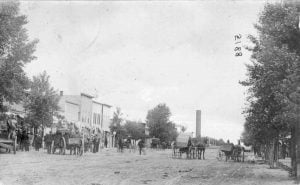History has been defined as a “systematic written account of events.” In presenting this sketch of some of the leading events of Brown County, Nebraska, I have endeavored to abide by that definition, though material of a reminiscent or narrative character may occasionally be included.
Another writer has said, “History is not made by documents, but by human beings.” The material I have collected and arranged for this sketch was, in the main, given to me by the early residents of this county. To them I shall always feel indebted for their assistance in compiling the facts which make up our county history. It is all inscribed in never-fading pictures on the memory tablets of our pioneers, those brave men and woman who endured the hardships of life in a new country that it might become a place of civilization. It this sketch serves to call to mind the efforts of these pioneers to found homes and to bring law and order to an uncharted wilderness, it will have served its purpose. To those who came in later years, I trust it may bring a slight understanding of what it means to be a pioneer.
Let us try to imagine what this portion of Nebraska was like before the coming of the white settlers. A great expanse of prairie, slightly rolling, spread out on every side as far as the eye could reach, most of it covered with a rich growth of grass. Some varieties of this grass were tall with stiff, straight stems, some of low growth with delicate, curling blades. Here and there were running streams which were hidden in canyons or ravines where trees and shrubs were found, but until the edge of the canyon was reached the entire country appeared to be “a sea of grass,” which stretched ever on and on toward the setting sun.
Over these vast plains wandered great herds of buffalo. In the spring and summer seasons they lived farther south, but came to this section for fall and winter grazing. The short grasses, dried by the burning summer suns, kept their flavor and nourishing qualities, thus furnishing excellent winter feed for these magnificent animals ( giving the name “buffalo grass”). The herds found water and shelter from winter storms in the canyons and the rough land near them.
Other wild animals were here in greater or less numbers-deer, antelope, coyotes, wolves, bears, prairie dogs, rabbits, prairie chickens, grouse, ducks, geese and a few fur-bearing animals. All found suitable homes in the trackless wilderness.
The region was ideal for hunting grounds, and long before the white men came to use it for that purpose, it was visited by roving bands of Indians. In the remote past there may have been resident tribes but earliest records show it was claimed by the Oglala and Brule tribes of the Sioux nation who held all of what is now northwest Nebraska, as far east as Long Pine canyon. These two tribes, with their allies, the Cheyennes and Arapahoes, fought other Nebraska Indians who lived in the eastern and southern sections of our state, to prevent them from hunting on these choice grounds. (It is believed that one of the last of these battles occurred about one and a half miles north of Long Pine, as battle scarred trees, human bones and broken fire arms were found there by early settlers.
It will probably never be definitely known just who the first white men were who saw the land now included in Brown county. After the settlements along the Atlantic coast became well established, several nations of Europe sent exploring expeditions into the middle west. Some were searching for gold and other precious treasure, some wished to claim the land for their governments, and others were led only by the love of adventure.
Lillian L. Jones
Early History of Brown County, Nebraska
- 1880-1881 Hard Winter in Brown County, Nebraska
- 1883 Election in Brown County, Nebraska
- 1890 Drought of Brown County, Nebraska
- 1893-1895 Drought Years in Brown County, Nebraska
- Ainsworth Public School
- Cattle Ranchers and Native Americans of Brown County, Nebraska
- Churches, Schools and Incorporation at Long Pine Nebraska
- County Courthouse of Brown County, Nebraska
- Courts and Law and Order in Brown County, Nebraska
- Early Mills of Brown County, Nebraska
- Early Visitors to Brown County, Nebraska
- Establishing a New County called Brown County, Nebraska
- Firsts in Brown County, Nebraska
- Fort Hartsuff
- Fort Niobrara
- Historic Trails of Brown County, Nebraska
- History of Ainsworth, Nebraska
- History of Johnstown, Nebraska
- History of Meadville, Nebraska
- Homestead Act in Brown County, Nebraska History
- Immigration in Brown County, Nebraska
- Interview with Nannie Hogan
- Items of Interest from Rock County, Nebraska
- Memories And Items of Interest
- Memories Of Long Pine, Nebraska
- New County Seat at Springview, Nebraska
- Newcomers to Brown County, Nebraska
- Outlaws and Native Americans in Brown County, Nebraska
- Outlaws and Pawnee Indians of Brown County, Nebraska
- Railroads and Cattlemen of Brown County, Nebraska
- Settlers from Bradford, Pennsylvania
- Winter of 1880-81 and Agricultural Fairs in Brown County, Nebraska

